Transformers: Dark of the Moon Review
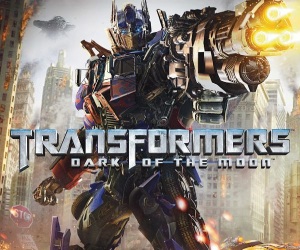 Game: Transformers: Dark of the Moon
Game: Transformers: Dark of the Moon
Developers: High Moon Studios
Publisher: Activision
Available on: PlayStation 3, Xbox 360 (Review on Xbox 360)
Every time a licensed game is released, a reviewer must make a compulsory reference to how bad such games usually are, especially if the game in question is being released to tie-in with a big-screen movie adaptation of the relevant IP. This review is no different.
Transformers: Dark of the Moon is a game based on a film, based on a television show, based on a toy, so expectations are hardly stratospheric. However, the game follows last year’s respectable Transformers: War for Cybertron, so it would not be inconceivable for it to buck the movie tie-in trend. Futher to this, the Transformers franchise has a passionate and (if we’re being honest) nostalgic fanbase to placate, one which is no doubt hungry to take on the roles of all their favourite characters. Can the game maintain high standards whilst fulfilling the fantasies of the series’ biggest fans?
STORY: Set somewhere between the events of Transformers: Revenge of the Fallen and the recently released film Transformers: Dark of the Moon, the game follows Optimus Prime and the Autobots as they scour the Earth for errant Decepticons. The story is told in seven chapters, each one allowing the player to control a different character. The first three chapters feature Autobots (Bumblebee, Ironhide and Mirage), the second three feature Decepticons (Soundwave, Laserbeak, Starscream and Megatron), and the final chapter gives the player a chance to take control of Optimus Prime himself. Each chapter takes the form of a mission in which the players must make their way in to or out of some kind of base in order to retrieve or destroy something.
This structure makes perfect sense from a gameplay perspective. After all, what’s the point of making a game about giant robots who can transform into different vehicles if you can’t play with them all? However, the episodic structure leaves the narrative feeling fractured and incoherent. Whilst it makes logical sense that the various characters would embark on different missions, it’s hard to remain invested in the story when the protagonist changes every hour. Admittedly, each of the characters are individually engaging (script-writing and voice-acting are both excellent), but the plot feels far more like seven short games rather than one long one.
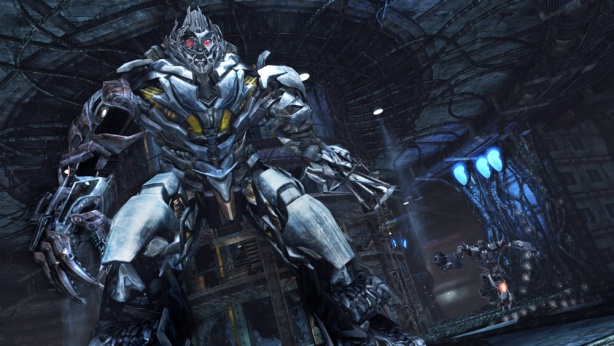
Further to this, it is a little jarring to find yourself switching sides so often. Sure, playing as Starscream is fun, but the peculiar sensation of controlling a character you have just been trying to kill erodes all sense of progression. Whilst many games use alternative protagonists to great narrative effect, the same technique in Transformers: Dark of the Moon is merely alienating. It also has serious consequences for gameplay, which will be addressed later.
GRAPHICS: For a game whose premise contains the potential for awesome spectacle, it’s a shame that Transformers: Dark of the Moon’s graphical presentation is merely serviceable. The Transformers themselves are nicely rendered in their robotic forms, but as vehicles they appear blocky and lacklustre. The environments, whilst superficially attractive, lack imagination and depth, and no effort is made to give you the illusion that you’re not just barrelling through corridors.
Although the decision to remove humans from the game was a wise one, their absence means that there is no real sense of scale, and the Transformers’ might is never really conveyed. Scatterings of human-sized objects (cars, houses) litter the maps, but they seem strangely out of place because the environments themselves have so clearly been designed with a Transformer-sized character in mind. Even areas which are supposedly human settlements are precisely the right height for a vast Decepticon, which means that you never feel as if you are truly controlling a massive character. Screaming humans, especially in the Detroit level, would have made the robots feel much larger, though it may well have pushed the age rating up.
SOUND: Thankfully, all the voice acting in the game is hugely entertaining. The lack of a coherent narrative doesn’t seem to matter so much when you’re listening to Soundwave’s psychotic utterances. Peter Cullen returns as Optimus Prime, and the rest of the cast do an excellent job of bringing the various characters to life. Whilst generic, the script is amusing, especially whenever the various Decepticons (boo, hiss) are involved. The soundtrack is appropriately orchestral, though more functional than decorative.
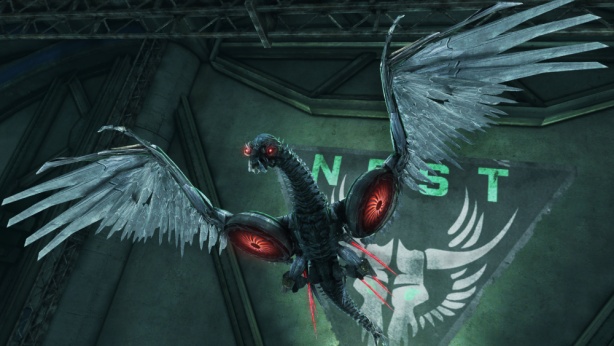
GAMEPLAY: Despite the fact that all its protagonists can transform into vehicles, Transformers: Dark of the Moon is a third person shooter at heart. For the most part, it’s a pretty decent one, with an impressive range of weaponry that offers players numerous ways of dispatching enemies. In their robot form, each character is equipped with two regular guns, the ability to throw grenades, and two rechargeable weapons mapped to the right and left bumpers.
It’s these weapons that elevate Transformers: Dark of the Moon above mediocrity, which is why it is such a shame that the game’s structure does not give players an incentive to make more use of them. The range is impressive: Mirage can render himself invisible, Laserbeak can unleash a devastating “whirlwind” attack, and Megatron can summon a horde of robotic underlings to dispatch unfortunate Autobots. Once used, players must wait for these powers to recharge before they can be used again, introducing a tactical element to gameplay.
However, unlike a lot of recent shooters which offer players a large variety of weapons, the gameplay is never allowed to develop. Although there is a points system and a score multiplier, you cannot cash points in for something worthwhile, like a stronger weapon or an upgrade. Instead, you are merely rewarded with an Achievement or Trophy whenever an arbitrary score is reached, leaving you with a slightly inflated gamerscore, but not much else.
Part of the problem is the structure: with a new character to control every hour or so, you’re never invested in your character’s development. This is extremely frustrating, because without an incentive to build upon your character’s strengths, there’s nothing to stop you simply mowing down all your enemies with the basic assault rifle with which every character is equipped. Although not every shooter needs to offer players the chance to upgrade their weapons (Gears of War and Halo manage just fine without this feature), Transformers’ fight mechanic and score system has far more in common with those that do (Bulletstorm, Bioshock, even Ratchet and Clank), so it feels odd that you’re forever flailing around in the shallow end.
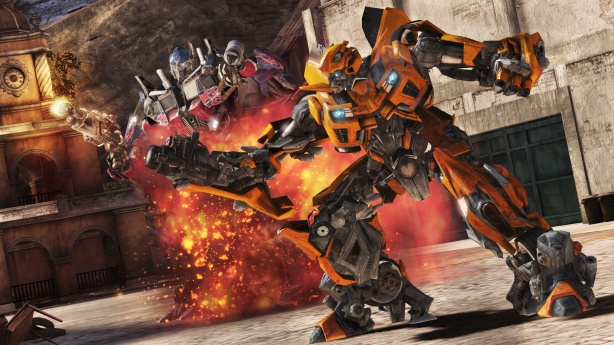
With all that in mind, it’s important not to neglect Transformers: Dark of the Moon’s USP: all the characters can transform into vehicles. A new addition to this game is “Stealth Force” mode, a form inbetween robot and vehicle that offers each character increased armour and manoeuvrability.
Sadly, this mode creates as many problems as it solves. On the one hand, Stealth Force allows strafing, meaning that there are few incidents when you are trapped in a corner, unable to back your way out. The powerful armour also means that you’re often able to escape from a hairy situation and wait for your health to recharge. On the other hand, the Stealth Force armour and weapons are so overpowered that battles can often be won by simply camping behind cover and popping out every now and again to deliver a volley of rockets.
The other issue is simply a consequence of poor design with regards to button-mapping. Whilst players can change from robot to Stealth Force forms with a click of the right analogue button, the regular vehicle form can only be accessed by pulling the left trigger whilst in Stealth Force mode. Not only is this confusing (pulling left trigger in robot mode zooms the target reticule), but it is also illogical, because left trigger also causes the vehicle to accelerate. This means that it is impossible to be in vehicle form without accelerating, and whilst this makes for some thrilling chase sequences, it reduces the vehicle modes (so pivotal to the franchise), to being little more than “boost” power-ups.
This would be less of a problem if the driving physics were better, but sadly, driving around in vehicle mode is akin to skating across a frozen lake, regardless of the intended texture of the terrain. Vehicles all feel feather-light, and there’s little difference between Bumblebee’s sports car and Ironside’s truck.
Lazy execution blights other areas of gameplay, something that it’s hard to forgive in such a mainstream game. Though not bug-ridden, environments are riddled with invisible walls, a design technique that is symptomatic of Transformers: Dark of the Moon’s total lack of environmental dynamicism. Despite the anaemic level design, there are nevertheless areas which a new player will try and explore, only to find themselves sliding off the transparent surface that obstinately blocks their path. There are alcoves and ledges, to be sure, but even those which logic dictates should be accessible are restricted by invisible barriers.
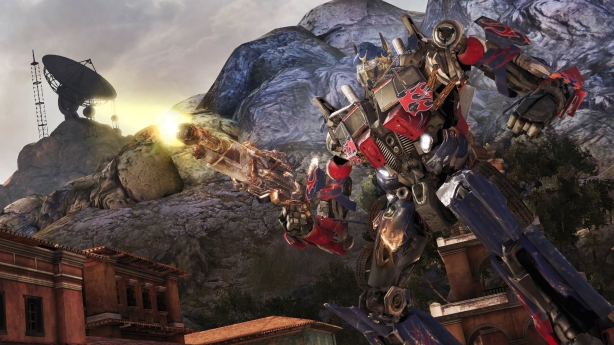
It’s not all bad news, however. As you would hope from a game that’s tied into a Michael Bay movie, there are a couple of genuinely thrilling set-pieces. One in particular allows you to control Starscream in his jet-engine form as he launches an aerial assault on the enormous Stratosphere. Although fans of flight simulators won’t be too impressed with the physics, the sequence offers not only a welcome change of pace at the game’s half-way point, but also the chance to indulge in a good old fashioned dog-fight. Adding to the excitement is the fact that Starscream must revert to his robotic form at certain points. Although the excitement is dampened a little by the fact that you cannot fly below the clouds (effectively reducing the danger in the mission to negligible levels), the sequence is still terrific fun.
MULTIPLAYER: In a way, multiplayer mode almost makes more sense than the campaign. Because there’s no narrative arc or difficulty curve, it makes sense to simply choose one character from the available selection, and enjoy all that the various weapons have to offer. The available modes are nothing out of the ordinary (deathmatch, capture the flag), but they take place on a selection of maps which again, are far better suited to the game’s graphics than the campaign mode’s corridors. What’s more, multiplayer actually allows you to level up and customise your characters, something that would have improved campaign mode no end. Once you reach a certain level however, you cannot improve your character any further, so there’s a limit to the entertainment that multiplayer can offer.
LONGEVITY: Whilst the campaign will neither last longer than eight hours nor tempt players back for repeat visits, the multiplayer mode does at least offer a few more hours of entertainment. However, its potential for development is over fairly quickly, meaning that there’s not a lot a of reason to hang around once you’ve hit your peak. Although the various weapons are fun to use in the multiplayer scenario, the experience just isn’t deep enough to warrant repeat visits.
VERDICT: Despite the numerous shortcuts and compromises that drag it down, there’s a good game lurking somewhere within Transformers: Dark of the Moon. The characters are fun to control and their various weapons are well thought out and effective. It is therefore a real shame that these core elements are brought down not only by poor production values (almost forgivable, given the speed at which one can assume the game was developed), but also by a campaign with a flawed structure that prevents players from capitalising on their skills and successes.
Whilst it is difficult to see how this problem could be solved without either reducing the number of characters which the player can control or dispensing with narrative altogether, it still means that Transformers: Dark of the Moon’s campaign simply can’t compete with that of comparable shooters. Whilst the multiplayer mode goes some way to addressing the issues, it just doesn’t do enough to make Transformers: Dark of the Moon the mould-breaking movie tie-in it could have been.






